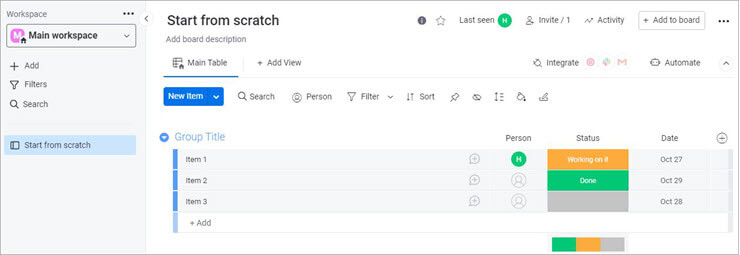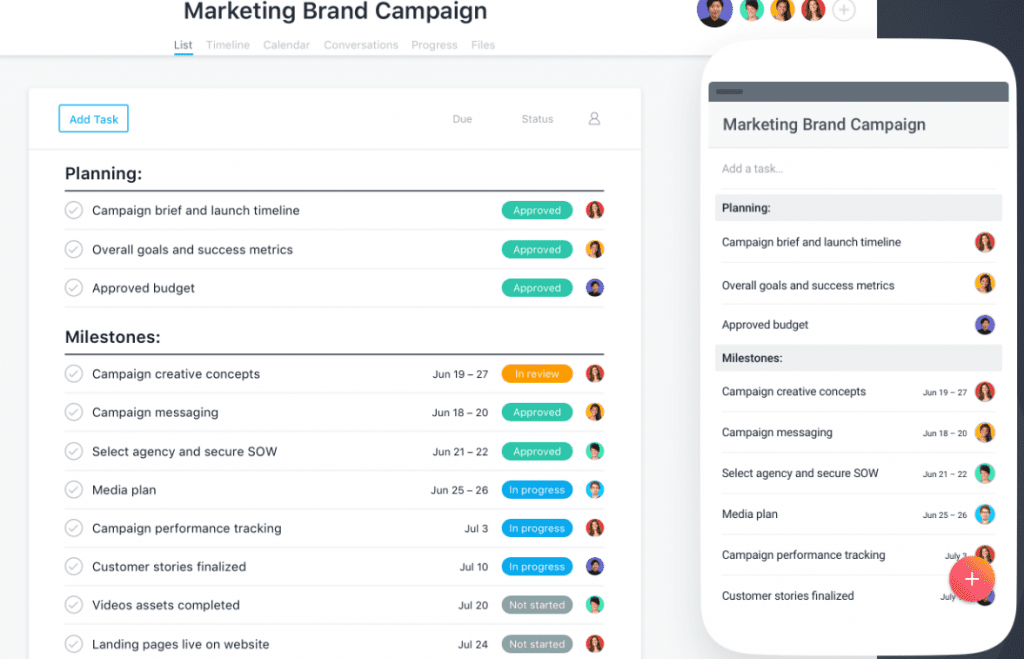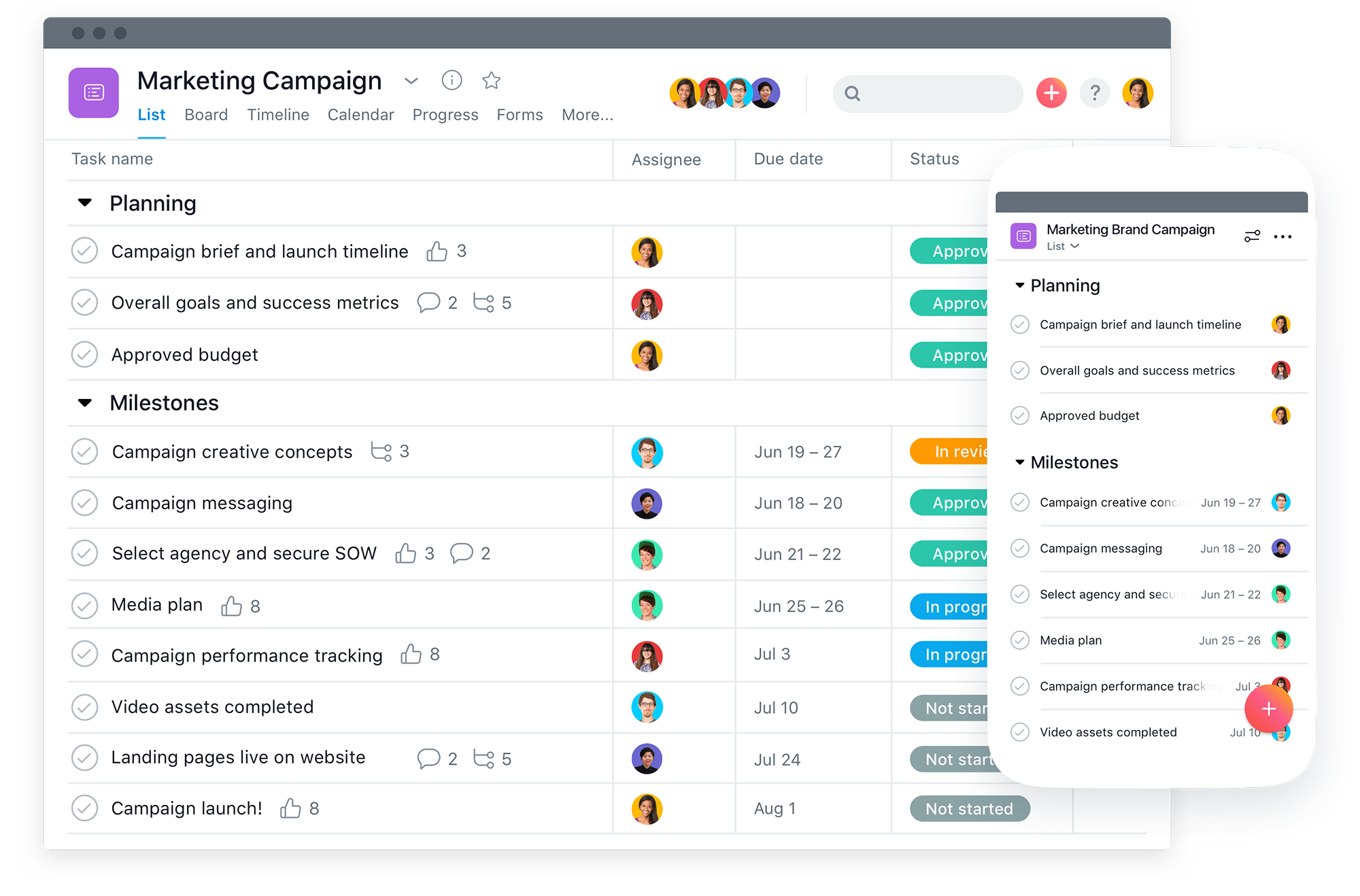
When it comes to project management software, teams often find themselves comparing platforms to discover which one best suits their needs. In the battle of monday.com vs asana, both platforms offer unique features and capabilities designed to streamline workflows, enhance collaboration, and improve productivity. This blog post delves into a comprehensive comparison of these two popular tools, helping you decide which is the right fit for your organization.
Monday.com vs. Asana: A Comprehensive Project Management Platform Comparison

Project management platforms have become indispensable in today’s fast-paced work environment. They help teams coordinate tasks, monitor progress, and communicate effectively. With a plethora of options available, monday.com and Asana emerge as two of the leading contenders, each with a distinct approach to project management.
monday.com offers a highly customizable interface that allows users to tailor their workflows according to their specific needs, while Asana provides an intuitive, user-friendly design with robust task management features. Understanding the key differences between them can significantly impact your team’s efficiency.
Overview of Monday.com
Monday.com is a Work Operating System (Work OS) that empowers teams to run projects and workflows more efficiently. With its visual interface, users can create boards to manage tasks, assign responsibilities, and track progress.
- Key Features: Users can utilize features like timelines, Gantt charts, Kanban boards, and custom dashboards. The platform also supports automation, allowing teams to set triggers for routine tasks, thereby reducing manual effort.
- Customization: One of monday.com’s standout features is its level of customization. Users can build boards tailored to their workflow, including color-coding, status indicators, and custom fields, making it suitable for various industries.
Overview of Asana
Asana is another leading project management tool focused on task management and team collaboration. Its clean design and structured approach cater to teams of all sizes looking to organize their work efficiently.
- Key Features: Asana provides powerful task management capabilities, including subtasks, due dates, priorities, and dependency tracking. Additionally, users can visualize projects through timelines, calendars, and lists.
- Usability: Asana’s strength lies in its user experience, providing a straightforward interface that helps teams easily navigate through their projects and tasks without unnecessary complications.
Summary
In summary, both monday.com and Asana have their strengths, catering to different types of teams and project management styles. While monday.com leans towards customization and flexibility, Asana excels in simplicity and task-focused features. Understanding these differences will guide you in selecting the right tool for your team’s unique requirements.
Key Features and Functionality: Deep Dive into Monday.com and Asana

A thorough understanding of the features offered by monday.com and Asana can illuminate their respective strengths and weaknesses. Below, we explore some of the key functionalities provided by both platforms.
Task Management
Effective task management is at the heart of any project management tool, and both monday.com and Asana excel in this arena.
- Task Creation and Assignment: Both platforms allow users to create tasks, set deadlines, and assign them to team members. However, monday.com offers a more visual approach, allowing users to view tasks in multiple formats, such as calendar views or Kanban-style boards. Asana, on the other hand, presents tasks in lists or boards, focusing on clarity and simplicity.
- Subtasks and Dependencies: Asana shines with its subtask feature, enabling users to break down larger tasks into manageable components. Additionally, Asana offers dependency tracking, which helps teams understand how tasks are related and prioritize appropriately. While monday.com has similar functionality, it may lack the same level of depth in managing task relationships.
Collaboration Tools
Collaboration is crucial in any project management setting, and both monday.com and Asana have equipped their platforms with collaborative features.
- Communication: In both platforms, users can leave comments on tasks, share updates with teammates, and tag individuals for immediate attention. However, monday.com’s integration of communication tools is more extensive, including built-in chat options and notifications that keep team members engaged.
- File Sharing: Asana offers seamless file sharing and integration with cloud storage services like Google Drive and Dropbox. While monday.com supports similar integrations, it also allows users to attach files directly to tasks, enhancing accessibility and organization.
Reporting and Insights
Tracking progress and performance is essential in project management, and both platforms provide reporting capabilities.
- Dashboards: monday.com stands out with highly customizable dashboards that provide real-time insights into project status and team performance. Users can create widgets to visualize data points relevant to their projects, fostering informed decision-making.
- Reporting Features: Asana’s reporting focuses on task completion and overall project progress. Users can generate reports based on filters like assignees, due dates, and project goals, ensuring they can visualize workload distribution and identify bottlenecks.
Conclusion
The feature sets of monday.com and Asana cater to different team needs. While monday.com emphasizes visual project management and customization, Asana prioritizes ease of use and task-oriented collaboration. Understanding these distinctions will help you determine which platform aligns best with your team’s operational style.
Pricing and Plans: Analyzing the Cost-Effectiveness of Monday.com and Asana

Cost is a critical factor when choosing a project management tool. Whether you’re a startup or a large enterprise, finding a solution that fits within your budget while providing adequate features is essential.
Pricing Models
Both monday.com and Asana offer tiered pricing plans to accommodate various team sizes and requirements.
- Monday.com Pricing:
- Basic Plan: Suitable for small teams needing core functionalities.
- Standard Plan: Offers additional features like timeline views and automation.
- Pro Plan: Provides advanced reporting, time tracking, and integrations.
- Enterprise Plan: A customized solution for large organizations requiring enhanced security and support.
- Asana Pricing:
- Basic Plan: Free for small teams with essential features but limited capabilities.
- Premium Plan: Advanced task management features and timeline views.
- Business Plan: Includes additional reporting, goal tracking, and custom fields.
- Enterprise Plan: Tailored solutions for larger organizations with dedicated support.
Value Proposition
While considering pricing, it’s important to assess the value proposition of each platform.
- Monday.com Value: The customizable nature of monday.com allows organizations to optimize their use of the platform, potentially maximizing their return on investment. However, for teams that require basic task management, the more affordable tiers might suffice, making it easier to scale as needed.
- Asana Value: Asana’s focus on task management makes it a compelling option for teams primarily looking to streamline workflows without the need for extensive customization. The free tier is beneficial for small teams or startups that want to test out the platform before committing financially.
Cost-Effectiveness
To evaluate cost-effectiveness, consider the features required for your team’s success.
- Feature Utilization: If your team heavily relies on advanced features like automations and integrations, monday.com may justify its higher price points compared to Asana. Conversely, if your primary need is simple task management, Asana’s lower-priced plans could be more cost-effective.
- Scalability: As your organization grows, consider the potential costs of upgrading plans. Both platforms provide scalable solutions, but evaluating the long-term financial implications is essential to ensure you’re investing wisely.
Conclusion
Pricing structures vary significantly between monday.com and Asana. By examining the features you most value, aligning them with your budget, and assessing the scalability of each plan, you can make a well-informed decision regarding which platform offers the best cost-effectiveness for your organization.
User Interface and Experience: Comparing the Usability of Monday.com vs. Asana
The user interface (UI) and overall experience play a vital role in how efficiently teams can utilize project management tools. An intuitive interface leads to faster onboarding and improved adoption rates.
User Interface Design
The UI of monday.com and Asana differs significantly, offering users unique experiences depending on their preferences.
- Monday.com’s Visual Appeal: The platform boasts a visually stunning interface, utilizing vibrant colors and customizable layouts to create engaging boards. The ability to personalize boards and dashboards gives teams the creative freedom to adapt the workspace to their liking.
- Asana’s Streamlined Layout: Asana takes a more minimalistic approach, emphasizing clarity and simplicity. The clean design eliminates distractions, allowing users to focus solely on their tasks. The dashboard is straightforward, making it easy for new users to understand where to find information quickly.
User Experience
Beyond design, the overall user experience is crucial for fostering productivity among team members.
- Onboarding Process: Both monday.com and Asana provide onboarding resources, including tutorials, guides, and customer support. However, Asana’s simpler layout may lead to a smoother onboarding experience for newcomers, particularly those less tech-savvy.
- Learning Curve: While monday.com offers extensive customization options, these features may come with a steeper learning curve compared to Asana’s straightforward task and project setup. For teams looking for quick implementation, Asana may be the more accessible choice.
Accessibility Across Devices
In today’s mobile-first world, accessibility across devices has become increasingly important for project management tools.
- Mobile Experience: Both monday.com and Asana offer mobile applications for iOS and Android devices, allowing teams to manage tasks and communicate on the go. However, Asana’s app is often praised for its speed and responsiveness, enabling users to stay productive while away from their desks.
- Cross-Device Synchronization: Both platforms excel in cross-device synchronization, ensuring that changes made on one device are reflected across all others. This consistency is essential for keeping teams aligned, especially those working remotely or in hybrid environments.
Conclusion
The user interface and experience of both monday.com and Asana cater to different preferences. While monday.com leans towards visual appeal and extensive customization, Asana fosters a streamlined, user-friendly environment. Evaluating the needs of your team members and their comfort level with technology will guide you in selecting a platform that enhances overall productivity.
Integration Capabilities: How Monday.com and Asana Connect with Your Existing Tools
Integrations are an integral part of project management platforms, allowing teams to connect their preferred tools and streamline workflows. Both monday.com and Asana offer a range of integrations, but the extent and ease of use differ.
Available Integrations
Understanding the integrations available on both platforms can help you assess their compatibility with your existing tools.
- Monday.com Integrations: monday.com offers numerous integrations with popular applications, including Slack, Trello, Google Drive, and Microsoft Teams. The platform also integrates with Zapier, enabling users to automate workflows across hundreds of third-party apps.
- Asana Integrations: Asana similarly boasts a wide array of integrations, partnering with tools like Zoom, Dropbox, Microsoft Office, and Salesforce. The Asana API allows developers to create custom integrations that enhance the platform’s functionality further.
Ease of Integration
The process of integrating other tools with your project management software can greatly impact user adoption and usability.
- Integration Setup: Both monday.com and Asana provide straightforward integration setups with guided processes. However, monday.com’s visual approach means users can see how integrations fit within their workflow directly on their boards.
- Automation Opportunities: Both platforms allow users to create automation rules based on integrations. For instance, users can automatically update task statuses in monday.com when a document is modified in Google Drive, enhancing workflow efficiency.
Customization Options
Customization is essential for tailoring integrations to fit unique organizational needs.
- Custom Fields and Data Mapping: monday.com provides extensive options for customizing fields and mapping data from integrated applications to suit individual workflows. This flexibility allows teams to create connections that conform to their processes seamlessly.
- Conditional Triggers: Asana also supports conditional triggers for automations, which can be valuable when combined with integrations. However, the level of customization may not be as granular as that found in monday.com.
Conclusion
Integration capabilities serve as a bridge between project management tools and the wider ecosystem of applications teams rely on. Both monday.com and Asana offer a robust suite of integrations; however, their approaches differ. Evaluating the specific integrations your team requires will help you select the platform that best supports your existing workflows.
Collaboration and Communication Features: Fostering Teamwork with Monday.com and Asana
Effective collaboration and communication are cornerstones of any successful project management endeavor. Both monday.com and Asana offer features that promote teamwork, but they do so in different ways.
Real-Time Collaboration
Real-time collaboration tools foster engagement and accountability among team members.
- Monday.com Collaboration Tools: monday.com includes features like activity logs, comments, and mentions directly within tasks. This enables team members to communicate about specific items without leaving the platform, ensuring that important details are captured in context.
- Asana Collaboration Features: Asana similarly promotes real-time collaboration through task comments and @mentions. Additionally, users can share project updates and feedback on overarching projects, facilitating transparent communication among all stakeholders.
Team Accountability
Ensuring accountability within teams is vital for delivering projects on time.
- Task Assignments: Both platforms allow users to assign tasks to team members, ensuring everyone knows their responsibilities. monday.com’s visual interface with colorful indicators can help track who’s responsible for what at a glance.
- Progress Tracking: Asana’s task completion checkboxes and progress percentage visualizations encourage team members to stay accountable and aware of their progress within projects.
Notifications and Updates
Keeping team members informed about project developments is essential for effective collaboration.
- Notifications in Monday.com: monday.com offers robust notification settings, allowing users to receive alerts based on their preferences, whether via email or in-app notifications. This ensures team members stay updated without being overwhelmed by unnecessary notifications.
- Asana’s Update Mechanism: Asana also provides notifications regarding task status changes and upcoming deadlines. Users can customize their notification settings, promoting efficient communication without distractions.
Conclusion
Collaboration and communication features in monday.com and Asana significantly enhance teamwork dynamics. While both tools offer solid collaboration options, monday.com’s visual approach fosters a more engaging environment, whereas Asana’s straightforward interface encourages team accountability. Choosing the right platform depends on your team’s specific collaboration needs and preferences.
Reporting and Analytics: Tracking Progress and Performance in Monday.com and Asana
Analytics and reporting features are essential for monitoring project performance and making data-driven decisions. Both monday.com and Asana provide valuable insights, yet their approaches differ.
Dashboard Customization
Customization in reporting dashboards allows teams to focus on the metrics most relevant to their goals.
- Monday.com Dashboards: monday.com offers a highly customizable dashboard that allows users to create widgets presenting various data points. Teams can visualize project progress, resource allocation, and workloads, empowering them to make informed decisions.
- Asana Reporting Features: Asana’s reporting capabilities focus on project completion and team productivity metrics. Users can generate reports based on custom filters and criteria, providing visibility into task dependencies and outstanding work.
Performance Metrics
Tracking performance metrics helps teams identify areas for improvement.
- KPI Tracking in Monday.com: Key Performance Indicators (KPIs) can be tracked using custom dashboards in monday.com. Teams can monitor metrics like task completion rates, overdue tasks, and team workloads to optimize their operations.
- Asana’s Goal Tracking: Asana enables teams to set goals at the project or company level, allowing users to align individual tasks with overarching objectives. This holistic view facilitates performance assessments based on strategic alignment.
Insights for Decision-Making
Data-driven decision-making is crucial for project management success.
- Real-Time Insights in Monday.com: Utilizing monday.com’s customizable analytics tools, project managers can gain real-time insights into team performance, enabling proactive adjustments to workflows and resource planning.
- Asana’s Reporting Capabilities: Asana’s reporting engine provides detailed insights into project timelines, workloads, and team performance, empowering leaders to strategize effectively and allocate resources where needed.
Conclusion
Reporting and analytics capabilities are vital for tracking progress and fostering continuous improvement. Both monday.com and Asana offer valuable insights; however, monday.com’s emphasis on visualization and customization may better serve teams seeking detailed analytics. Assessing the reporting needs of your organization will guide you in choosing the right platform for effective performance tracking.
Which Platform is Right for You? Monday.com vs. Asana: A Decision Guide
After exploring the various aspects of monday.com vs asana, it becomes clear that both platforms cater to different project management needs. To assist you in making an informed decision, we’ve compiled a decision guide to highlight the considerations you should take into account.
Consider Your Team Size
- Small Teams: Asana’s free tier and simplified task management features may be ideal for small teams just starting with project management tools.
- Larger Teams: monday.com’s extensive customization options and robust reporting capabilities may be more suitable for larger organizations that require intricate workflows and detailed analytics.
Identify Your Primary Needs
- Task Management Focus: If task management is your primary concern, Asana’s intuitive design and straightforward features make it a fantastic choice.
- Customization Requirements: If your team thrives on customizing workflows and visualizing project progress, monday.com offers the flexibility you may desire.
Evaluate Your Budget
- Cost Sensitivity: If budget constraints are critical, consider Asana’s free plan for smaller teams or the lower-tier options for basic functionalities.
- Investment in Advanced Features: If you foresee the need for automation, advanced reporting, and extensive integrations, investing in monday.com may provide greater long-term value.
Organizational Culture
- Creative and Collaborative Teams: Teams that prefer a visually engaging workspace may resonate more with monday.com’s vibrant interface and customization options.
- Efficiency-Oriented Teams: For those who value simplicity and quick access to task-focused features, Asana’s minimalistic design will likely align with their culture.
Conclusion
In the realm of project management software, both monday.com vs asana stand out as strong contenders, each offering unique strengths tailored to different types of teams. Through a detailed examination of their features, pricing, usability, integration capabilities, collaboration tools, reporting, and analytics, we’ve uncovered the nuances that set these platforms apart.
Ultimately, the decision hinges on your organization’s specific needs, resources, and the way your team prefers to work. By carefully considering these aspects, you’ll be better positioned to choose a tool that fosters productivity, enhances collaboration, and contributes to your team’s success. Whether you lean toward the visual flexibility of monday.com or the task-oriented design of Asana, investing in the right project management tool is sure to pay dividends in efficiency and performance.